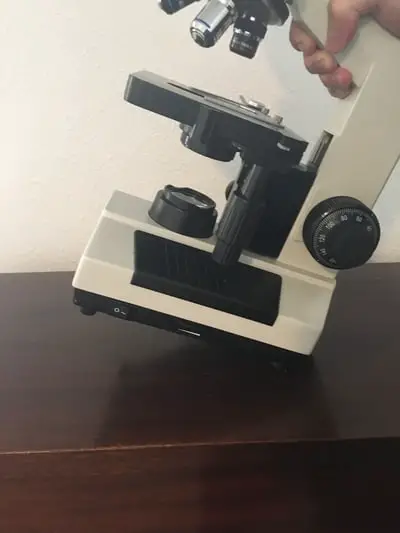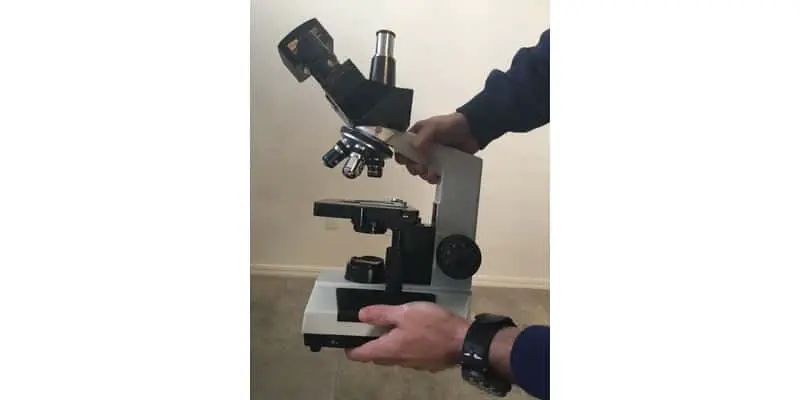Microscopes are highly precise instruments and are often times extremely expensive. Some microscopes are deceptively heavy and if you are not holding the microscope properly you increase the chances of dropping or dislodging another component of the microscope. If you are going to be using a microscope frequently you need to know how to carry one.
The proper way to carry a microscope is to grasp the arm of the microscope with your dominant hand, lift the microscope up slowly, and use your other hand to firmly hold the base to stabilize the microscope as you transport it from one place to another. Never hold the microscope by the objective lens or the microscope stage. This can lead to minute misalignments that can cause distortion and issues with image formation.
In this post we will dive into more of the specifics on how to properly carry different types of microscopes and equally as important what things you should avoid doing when you carry your microscope that can prevent you from seriously damaging or microscope.
Setting the Microscope Down
Before you start carrying the microscope always know where you are going to put it. If you are putting the microscope back in a case or a cabinet make sure you have it open before you start transporting the microscope. I have seen students and microscope enthusiasts who are carrying the microscope perfectly until they get to a cabinet or case that they forgot to open beforehand, and they take their stabilization hand off the microscope and start holding it with one hand while they open the cabinet.
For smaller microscopes this is not that big of a deal although not recommended. For larger heavier microscopes this can be a recipe for a costly disaster. After your cabinet, case, or other resting place for your microscope is accessible we need to make sure that we don’t damage the microscope when we set it down. If you’ve ever been in an airplane, you’ve probably been on a flight with a very smooth landing and one with a rough lading. There is a noticeable difference between the two and we want to make sure we give our microscope the smoothest landing possible.
When you put the microscope down make sure you set the base of the microscope down with all four corners landing on the surface at the same time. You should never put two corners down first and push the microscope forward to let the other two corners land with the weight of the microscope as shown in the image below. While this may not result in damage the first or even the second time you do it, over time it can cause misalignments that can add up to very annoying image formation problems.

Things to Avoid When Carrying a Microscope
There are several things to avoid when carrying a microscope that can save you from making a very expensive mistake. Some of these may seem like common sense but you would be surprised at how common some of these mistakes are.
- Don’t ever carry your microscope by the objective lens or the stage. These components are not meant to endure the weight and pressure that is applied if you use these to carry the microscope.
- Always make sure all plugs and wires are unplugged from their respective power source. I almost did this one time nearly lost my grip and dropped my microscope because I did not unplug my USB cable from the microscope camera port.
- Never hold the microscope with one hand. You may be able to get away with this when handling lighter microscopes but with heavier microscopes this can easily lead to dropping the microscope.
- Never attempt to carry a microscope while a wet slide is engaged on the stage.
- Always remove any camera mounts before moving the microscope. The weight of the camera can cause a weight imbalance to make it awkward to handle.
- Never move a microscope while the microscope cover is still on.
I Dropped My Microscope Now What?
If you dropped your microscope don’t panic everything may still be ok. First test some of the core parts of the microscope to make sure everything is still working properly. Raise and lower the stage using the coarse and fine adjustment knobs. Raise and lower the condenser rack. Turn the microscope on and make sure the illuminator works and you are able to adjust the light intensity. Next, we need to actually test the optics of the microscope which are the most vulnerable to a drop.
Take a prepared slide that you are familiar with and make sure you are able to see what you expect to see in the slide. Look for any distortions or cracks. If you dropped the microscope with the camera still attached, you need to test that too. Turn on the microscope camera and ensure there are no abrasions or scratches that will impair the image quality of the camera. If you have checked these components and everything looks good you lucked out. If you find issues with any objectives, you will need to evaluate and determine if the damage warrants replacing the part.
If you damage any optical part of the microscope that can be interchanged like an objective or condenser just replace that individual part. If there is damage to the internal optics inside the body of the microscope you will need to determine if you want to try to repair it or just get a new microscope. Obviously, this is a decision that will be based on the cost to replace versus cost to repair. To get an idea of how much new microscopes can cost check out this post.
Takeaways
Understanding how to carry a microscope may seem like the last thing you want or need to think about, but it can really save you an expensive headache. If you avoid some of the mistakes listed in this post and always use two hand you will be just fine. If you do accidentally drop your microscope stay calm and carefully evaluate the damage and assess the options outlined in this post. Microscopes are fun but so is safety!

